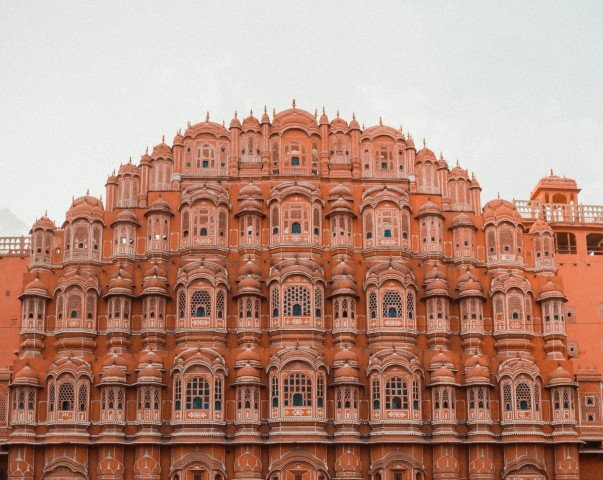Islamic architecture is a powerful example of the coexistence of form, function, and faith. Islam and architecture are renowned for the creative complexity, environmental responsiveness, and geometric accuracy. It has influenced the built world for about 1,400 years.
Islamic buildings are always changing and teaching us important lessons about sustainable and culturally oriented islamic architecture design.
This article examines the rich history and evolution of Islamic architecture in Spain, islamic architectural art, islamic architecture mosque, and a comprehensive overview on islamic architects.
Origins of Islamic Architecture
Islamic architecture started to emerge in the seventh century CE as Islam gained popularity. Many people believe that Islamic architecture design originated at the Prophet Muhammad’s home in Medina, which doubled as a mosque and a place to live. Its straightforward courtyard design with covered porticoes was used in the construction of several mosques.
Early Islamic architecture art was more than just ornamental. It exemplified the fundamental Islamic principles of balance, order, and harmony. Therefore, rather of using realistic representation, calligraphy, symbolic geometry, and repeating patterns.
Byzantine domes, Sassanid arches, Roman columns, and North African courtyards were among the many inspirations that shaped architecture of islam.
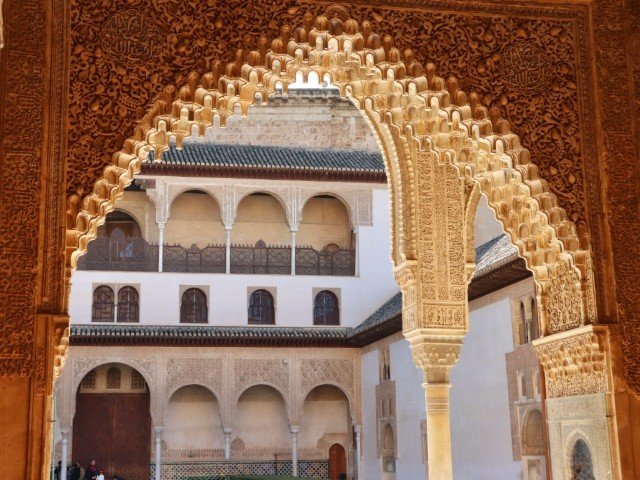
5 Primary Features of Islamic Architecture Design
Islamic architecture design has multiple recognized aspects over centuries and nations. Its most famous design characteristics are the following:
1. Structured Geometry
Generally an Islamic architect uses geometry to communicate a heavenly sense of order as well as beauty. Arabesques, tessellations, and star patterns depict infinity and the oneness of all creation, which are two key Islamic architecture modern concepts.
2. Aesthetic Calligraphy
Islamic buildings usually use highly stylized Arabic calligraphy to incorporate Quranic texts in place of visuals. This kind of islamic architecture art transforms elements like domes, islam arch, and mihrabs into spiritual canvases.
3. Domes and Arched Forms
Islamic architecture, like the Blue Mosque in Istanbul and the Dome of the Rock in Jerusalem, provide uplifting and stimulating spatial experiences. These domes are architectural and spiritual marvels, often richly adorned with tilework, muqarnas, and light filtered through intricately carved screens.
4. Muqarnas: Precision in Pattern
Islamic architecture art is characterized by muqarnas, which are stalactite-like forms found in recesses and transitional components. Their complexity exhibits a high level of engineering knowledge while preserving aesthetic coherence.
5. Sacred Spaces and Garden Geometry
Inspired by the Quran’s depiction of heaven, Islamic architects incorporated nature into their creations. Palaces, mosques, and tombs. Including the most well-known, the Taj Mahal all have charbagh gardens. Water canals separate them into quadrants.
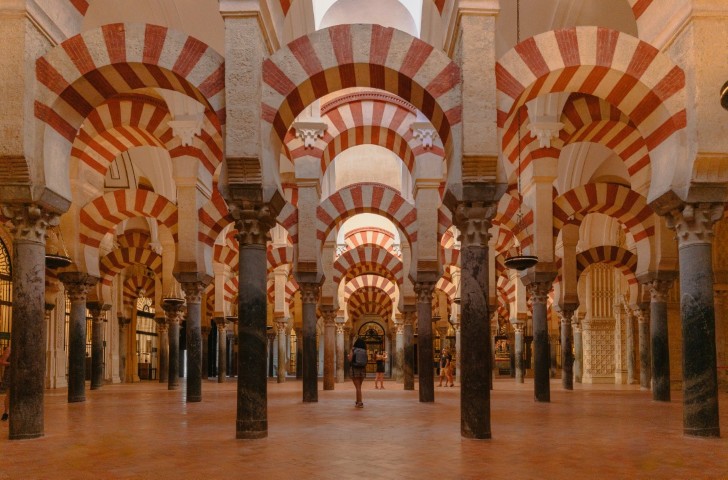
Islamic Architecture in Spain: From Cordoba to Granada
Spain, notably Andalusia, which was governed by Islam for almost seven centuries, contains some of the most well-known examples of Islamic architecture outside of the Middle East.
Córdoba’s Islamic Architecture Mosque
Converted from an islamic architecture mosque to a cathedral in 784 CE, the Mezquita is a magnificent example of Spanish Muslim architecture with Christian elements. Its renowned double-tiered horseshoe islamic arch, infinite colonnades, and elaborate mosaics are proof of both Umayyad ingenuity and Andalusian skill.
Granada’s Alhambra: A Jewel of Muslim Architecture in Spain
The Alhambra, a fortress-palace complex with beautifully carved stucco, arabesque tiles, muqarnas ceilings, and mirrored water basins, is considered the pinnacle of Islamic architectural creativity. Because it integrates poetry, geometry, and nature, it exemplifies Islamic design philosophy.
These constructions show how Islamic structures in Spain were more than just houses of worship; they were also vibrant cultural hubs that influenced the arts, agriculture, and urban design.
Islamic Architecture Mosques
The mosque is Islamic culture’s most prominent architectural style. Islamic mosque design has progressed from small beginnings to large, multipurpose ones.
5 Key Features of Islamic Architecture Design in Mosques:
- Mihrab – A decorated prayer niche indicating the direction of Mecca (qibla).
- Minbar – The pulpit from which the imam delivers sermons during Friday prayers.
- Minaret – A tall tower used to call the faithful to prayer.
- Courtyard (Sahn) – An open space to accommodate large congregations and overflow prayer.
- Ablution Fountain (Wudu Area) – A water feature used for ritual washing before prayer.
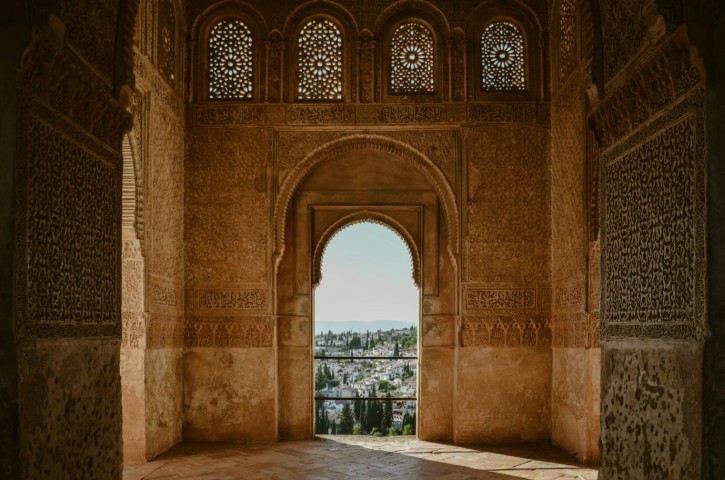
Islamic Buildings Meet Sustainability
Despite popular belief, Islamic architecture has developed to embrace modern construction practices such as LEED certification, green building design, and passive sustainability principles.
4 Islamic Architecture Modern Features and Sustainable Techniques
- Thick Walls – Provide thermal mass to regulate indoor temperatures by absorbing heat during the day and releasing it at night.
- Wind Towers (Badgirs) – Traditional Persian elements that capture and direct wind into buildings for natural ventilation.
- Mashrabiya Screens – Ornamental wooden latticework that filters sunlight and enhances airflow while preserving privacy.
- Interior Courtyards – Central open spaces that help cool surrounding rooms and create comfortable microclimates.
2 Famous LEED-Certified Islamic Buildings
1. KAPSARC Mosque
Zaha Hadid Architects designed the KAPSARC Islamic Architecture mosque in Riyadh, Saudi Arabia, using eco-friendly materials and cutting-edge parametric design. With energy-efficient technologies and regionally appropriate materials, the project promotes sustainability while displaying creative architectural forms.
2. Cambridge Central Mosque
Located in Cambridge, United Kingdom. Europe’s first eco-mosque, is setting a new standard for ecologically conscious Islamic construction in the modern day. This stunning Islamic structure expertly combines current environmental concerns with traditional Islamic architectural design elements such as geometric patterns and spatial harmony.
The mosque is an example of Islam’s changing architectural style, built using cross-laminated timber and a passive ventilation system. In addition to being a place of worship, it is an excellent example of contemporary Islamic design that stresses environmental sensitivity and spirituality.
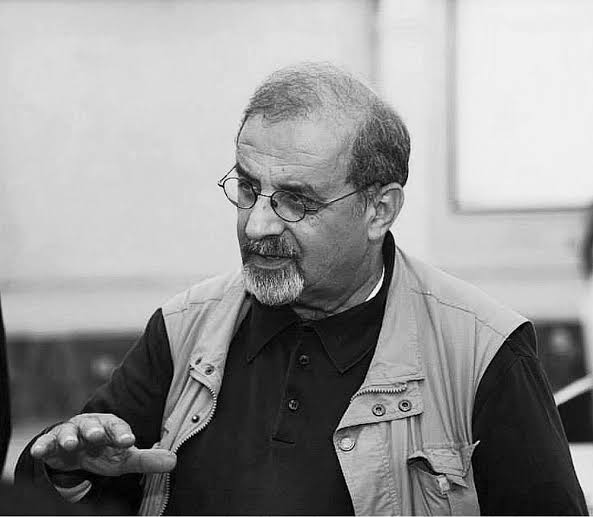
3 Famous Islamic Architects
1. Zaha Hadid Architects
Her characteristic flowing designs frequently incorporate abstract geometry, sophisticated rhythms, and spatial compositions reminiscent of classic Islamic design concepts, despite the fact that she is not solely interested in Islamic architecture design.
Zaha Hadid’s work reflects the spirit of Islamic architecture via dynamic movement, layered intricacy, and a rethinking of geometry that is consistent with the visual language found in older Islamic projects. Her architecture combines Islamic architectural elements with contemporary expression.
2. Rasem Badran
Rasem Badran, a notable Palestinian-Jordanian architect, is known for his ability to combine traditional building with modern design concepts. His work is heavily influenced by the cultural, historical, and environmental contexts of each site, particularly Jordan and the greater Middle East region. Badran’s architectural philosophy emphasizes the use of locally sourced materials and techniques, the rehabilitation of traditional Islamic architectural components, and the creation of human-centered environments.
He honors the Islamic architectural history while addressing current urban and environmental concerns via his work, which connects the past and present. Islamic architecture’s utilitarian and spiritual qualities are represented in his structures, which typically feature courtyards, shaded arcades, and wonderfully framed vistas.
3. Sami Angawi
The preservation of traditional Hijazi architecture and the resurrection of holy geometry are credited to famous Saudi scholar and architect Sami Angawi. His work is focused on the idea that architecture should reflect environmental balance, cultural identity, and spiritual harmony. Angawi combines current sustainability techniques with traditional Islamic architectural aspects like as mashrabiyas, natural ventilation, and geometric design, relying on the rich heritage of the Hijaz region, notably in Mecca and Medina.
He has spearheaded a variety of educational and restoration programs to preserve Western Saudi Arabia’s architectural past through his organization, the Amar Center for Architectural Heritage.
Conclusion: Why Islamic Architecture Still Matters Today
The beauty of Islamic architecture lies in its ability to consciously adapt to the environment, spirituality, and social purpose, in addition to its well-known domes and brilliant tiles. Islamic architecture reflects both practical demands and spiritual aims, and every aspect respects both the worldly and the holy in this architectural style that combines art and science.
This architectural history continues to inspire, from the historic triumphs of Islamic architecture in Spain to modern Islamic structures that meet contemporary sustainability and green building criteria. It provides a paradigm for modern designers and Islamic architects that is spiritually meaningful, technically sound, environmentally conscious, and culturally relevant.

